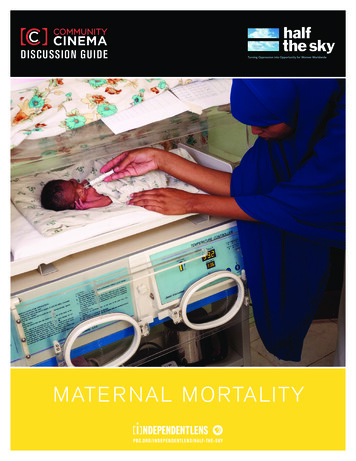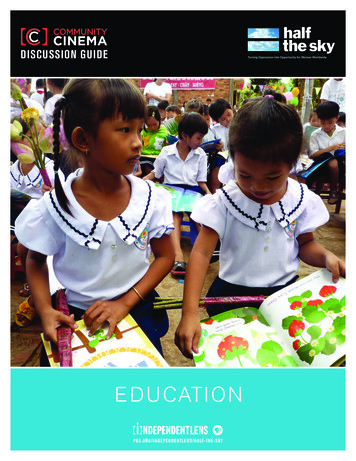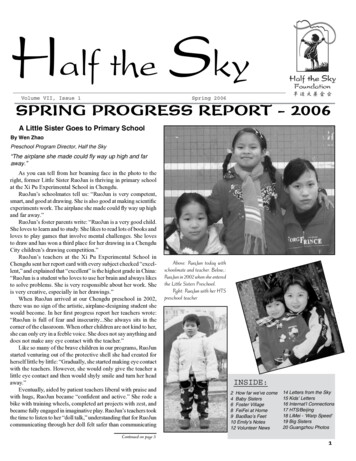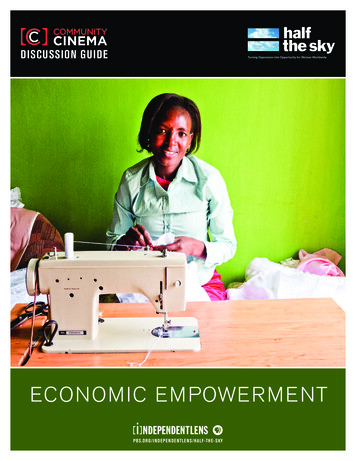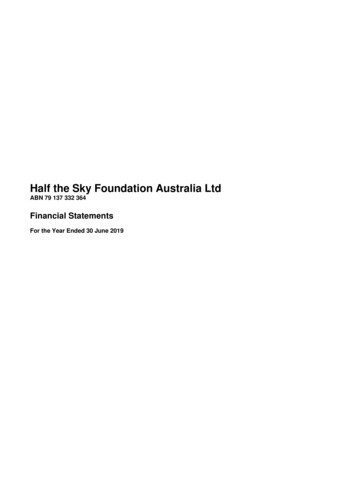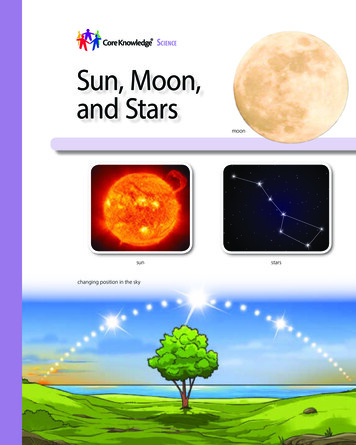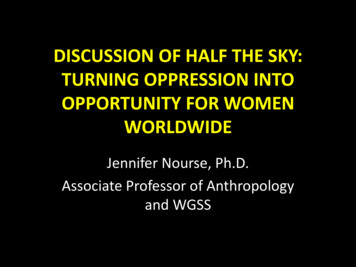
Transcription
DISCUSSION OF HALF THE SKY:TURNING OPPRESSION INTOOPPORTUNITY FOR WOMENWORLDWIDEJennifer Nourse, Ph.D.Associate Professor of Anthropologyand WGSS
WANT TO BRIEFLY TELL YOU WHY I AM HERE TALKINGWITH YOUMost recent research 20092010 was on Rural Women’sReproductive Health inIndonesia. I came there tounderstand why so manywomen were dying inchildbirth. I worked at an IndonesianHospital and looked atreproductive health deliveryfrom many angles.But this was not my first timethere
Original & Current Research inSulawesi
Originally began research for Ph.D. inCULTURAL ANTHROPOLOGY LAUNCHED MY CAREER WITH A FULBRIGHTGRANT FOR PH.D. RESEARCH IN INDONESIA1984-1986. Learned the National language And an unwritten Local one.
ONCE LEARNED LAUJE MOVED TOMOUNTAINS TO LIVE LIKE THEY DID—2YEARS
Found out that the whole culture believesthere are birth spirits that must benurtured For local Lauje people, ifthese spirits were notnurtured through offeringsto the placenta and theumbilical cord, then thesespirits would call the soul ofthe child to join it again inheaven. This could happento the mother as well. Itwas incumbent upon thefather and other relatives tomake offerings so thechildren and the womenwould live.
Elaborate system of offerings surrounded theirbeliefs about health and life. I workedWith midwivesand shaman tolearn how togive theseofferings to theplacentalspirits of theuniverse
This work resulted in my Ph.D. anda book called Conceiving Spirits: Birth Rituals andContested Identitiesamong Lauje ofIndonesia(SmithsonianInstitution Press).
Over the years I kept going back My goal was to see myfriends And to start a newproject on midwifery. The Indonesian state wasbringing in trained nursemidwives from moreurban areas ofIndonesia. I wanted to see howpeople responded tothis.
They were thrilled. They wanted the“governmentmedicine” so womenwouldn’t die inchildbirth
Every summer after I got tenure Ireturned to visit my friends But many of my friendswere dying in childbirth. Every summer I wouldreturn and find more ofmy friends, or theirsisters, or cousins weredead. It washeartbreaking. It wasthen I decided to channelmy grief into interviewingdoctors and midwives atthe health clinics
Traditional Birth Attendants and LaujeWorldview Despite the high death rates,highland women refused to seekmedical help. Instead they relied on “traditionalbirth attendants.” (TBAs), elderwomen in the community, often arelative, who had a great deal ofexperience in birth, though thisdoes not make them able to dealwith high risk births. These TBAs assisted birth usingethnic and religious knowledgetied to the Lauje worldview aboutplacental spirits and how toplacate them so mothers andinfants would live through thebirth process.
Risking their lives for Dignity Returning to work with the Lauje everysummer I could in the 1990s, I wasemotionally distraught to hear thenames of the many Lauje friends whohad died in childbirth or fromcomplications. “We will never return [to the publichealth clinic] ” “They treated us likeanimals.” .” “I would rather die that suffer thathumiliation” said a few people. Otherstold me “the clinicians made me pay forservice.”: “It was supposed to be free.”“I have no income. I cannot return.”
So I decided to research local health care andmaternal mortality rates. Before finishing my discussion of my work,let’s discuss Half the Sky. Thoughts/ Impressions? Did you like it?
I was Prepared to be skeptical Overall I like the book Human factor helps, but often suchbooks don’t see particular context asrelevant Also, such books tend to be about great“white” European/American savior This connected the reader to individuals But there are some issues—some of ithas to do with the organization.
INTRO—The Girl Effect Pp. xi-3—Story of Srey Rath– Cambodian girl sold into sexslavery– runs away from brothel butreturned– Stays due to children– Children finally saved
Chapter One –Emacipating21st century slaves Pp. 3-22 ration of girls to boys– In India 108 boys to 100 girls– In China 107 boys to 100 girls– Learn that women are key toending hunger– Progress achieved throughwomen– Seattle school helps to fightslavery through education forgirls
Chapter 2-Prohibition& Prostitution P. 23-46 Is it better to giveTrafficked girls condoms andhealthcare or Arrest traffickers, especially thosewho sell virgins Case of the Netherlands vs. Sweden Rescuing girls is the easy part—2cases P. 45 read quote
Chap. 3 Learning to Speak Up P. 47-60 Girls havestoic docility—what’sthis? P,. 55 Progress depends onpolitical and culturalremedies Charisma important Story of Sunitha
Chapt. 4 Rule by rape Pp. 61-81 Rapex, what is this? Lots of examples from Africa. Rape and violence not where wehave been focusing on genderinequities— Rape also has to do with .? In the end, religion, governancecome into the mix when there arefewer rapes / suicides
Chapter 5 The shameof honorPp. 81-93Dina and honor killingFlood of rapes from AfricaRape and honor killingsget conflated here Talks about HarperMcConnell in Africa—doing wonderful work
Maternal Mortality—one woman aminute Stories of fistulas andrape—the hyena story P. 97 attributes this towomen being pariahs. P. 103 most effectiveapproaches aren’t medicalat all—e.g. subsidize schooluniforms Work to avert maternaldeath and disability AMDD
Chapter7 why do women die inchildbirth? Great explanations—4 reasonsBiologyLack of schoolingLack of rural health systemsDisregard for womenWhat could be another reason?—poverty,inequities ingovernment, ethnicity, neoliberal economy. Let’s look atmy Indonesia research for a few minutes
WhenCompared toNeighboringCountriesand R FOR 2011Italy4Canada7United Kingdom8Singapore16United olivia180INDONESIA228Afghanistan1,575
The Question is Why? Answers should be– complex and context based Recent health policies in Indonesia– Assumed one “answer” is cause—geography &demography answers prevailed Example—High MMR in Indonesia due to poor access—unique geography– Money thrown at the one “answer” but didn’t alwaysreach locals– Inadequate results
In the last 30 years Indonesia’spopulation has doubled Land becoming lessavailable Crowding more common Water more polluted incrowded areas Disease more likely Also more landslides anddifficulty travelling Especially during corruptSuharto Regime
The reasons orexcuses used byplanners in NationalDept of Health(what I call thegeography anddemographytheories) cannotexplain theinequities betweenrural peripheriesand urban centersURBAN PROVINCES ININDONESIAProvince or MMRCityRURAL PROVINCES ININDONESIAProvince,MMRCity, orDistrictSurabayaCity (E.Java)CentralSulawesiProvince(Sulteng)Palu, ct(Sulteng)24Province of 30E. JavaProvince of 79SouthSulawesi274200277229
Many Authorities regard the poor maternalhealth outcomes of Central Sulawesi as due to: Lack of Access Few SkilledAttendants InadequateFunding to bringskilled attendantsto remote areas Too many patientsfor too few trainedhealthworkers
Depends on which District one isin Corrupt health officialsskim off money meant forhealthcare Or intensive use of landcreates problems withclean water. One leader campaigned tostop the corruption. Where I worked in CentralSulawesi, they elected awonderful leader whobuilt roads and brought inpipes for clean water.
ACCORDING TO THE LAUJE WITH WHOM I HAVE BEENWORKING SINCE THE 1980S, DECENTRALIZATION IS GOOD. “Life here is better, there is clean water and better roads. The doctors can reach usbetter. We want a doctor here, and that will come later. When we talk to theBupati (the head of the regency), he listens to us. We have much better healthcarethan when you lived here before [during the Suharto era].” “It is expensive but wecan get care and they don’t treat us like animals.” We go to the nurse midwives inLombok.LAUJE MTNS.1984LAUJE MTNS.2010
Dysentery prompted Drs. And Regent Longki to asklocals what they thought would improve healthcare.Clean water they said.
REDUCTIONS IN MMR & IMR (MATERNAL & INFANTMORTALITY RATES) HAVE SLOWLY CHANGED. THEY ARE KEYINDICATORS USED BY THE WORLD HEALTH ORGANIZATION TOMEASURE HEALTH ��SMMRCOUNTY’SMMR2004 1001022996462005 2543633011352006 1671672712942007 1311921893202008 1271312073292009 ?68229136
Many Authorities regard the poor maternalhealth outcomes of Central Sulawesi as due to: Lack of Access Few SkilledAttendants InadequateFunding to bringskilled attendantsto remote areas Too many patientsfor too few trainedhealthworkers
But it is also attitude and bigger issues—lack of healthin general poverty—lack of trust in the government. Outsiders who come into anarea cannot help locals.They have to live in an areato gain trust. Now nurses live in the areaand know the people. Grandchildren of formermidwives are now trained asnurses. This is one of thebiggest changes.
NEIGHBORING COMMUNITIES ATTEND THE CLINICS andTHEY NOW RECEIVE FREE MEDICAL CARE ON PARTICULARDAYS. Fewer babies are dying.
HAUGHTY HEALTH STAFF AND DOCTORS DO NOT KEEPPEOPLE FROM ACCESSING HEALTHCARE AS THEY ONCEDID IN THE SUHARTO ERA EVEN IN AREAS WHERE THE MAYOR MAY BE CYNICAL, THERE ARE NURSE MIDWIVES EMBEDDED IN THE COMMUNITIES WOMEN AND CHILDREN TEND TO GO TO THESE MIDWIVES FOR ALL OF THEIR HEALTHCARE— NOT JUST REPRODUCTIVE HEALTH. RURAL MEN VISIT THESE NURSE-MIDWIVES AS WELL DOCTORS TEND TO PROVIDE SERVICES FOR MIDDLE CLASS MEN AND RURAL WOMEN AND CHILDREN IN COMMUNITIES WITHOUT MIDWIVES.
ACTIVE, COMMITTED AND ENGAGED LEADERS AREINDEED FOCUSING ON THE POOR SUCCESS DUE NOT ONLY TOCOMMITTED (AND UTOPIAN)LEADERS BUT ALSO TO DECENTRALIZEDHEALTH’s FUNDING STRUCTURE NATIONAL PROGRAMS ARE TELLING PEOPLETHAT HEALTH IS A HUMAN RIGHT. THEYARE SEEING THIS AND WANTING EQUALITY. BUT THIS VARIES DEPENDING UPONREGION.SOME ARE GOOD, AND OTHERS ARE JUSTAS CORRUPT AS BEFORE. AND COMMITTED LEADERS MAKE SURETHE MONEY IS SPENT AS IT SHOULD BESPENT—FOR THE PEOPLE.
DISCUSSION OF HALF THE SKY: TURNING OPPRESSION INTO OPPORTUNITY FOR WOMEN WORLDWIDE Jennifer Nourse, Ph.D. Associate Professor of Anthropology . a book called Conceiving Spirits: Birth Rituals and Contested Identities among Lauje of Indonesia (Smithsonian Institution Press).



